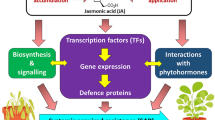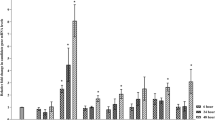Abstract
Nonhost resistance is a durable and broad-spectrum resistance in plants that are outside of the given pathogens’ host range. Previously, we reported that the important pathogen Xanthomonas oryzae pv. oryzae (Xoo), which causes bacterial blight disease in rice, rapidly triggers the hypersensitive response (HR) and nonhost resistance in its nonhost plant Nicotiana benthamiana. In this study, we optimized the conditions, including the inoculum concentration, the leaf positions for inoculation and the plant post-inoculation growth temperature, to induce Xoo-triggered HR and nonhost resistance. We demonstrated that inoculating with a Xoo concentration of 1 × 108 cfu mL−1 in fully expanded leaves of N. benthamiana plants resulted in the strongest induction of HR and nonhost resistance. Furthermore, we probed the role of hydrogen peroxide (H2O2) in Xoo-induced HR and nonhost resistance. An exogenous supply of H2O2 accelerated Xoo-induced HR, while the elimination of H2O2 by the application of a catalase blocked the HR-mediated suppression of bacterial growth in N. benthamiana. Moreover, ∆hrpD6 and ∆hrcU Xoo mutants, which are deficient in H2O2 production, did not show an induction of HR, while another Xoo mutant, ∆hpa1, caused a strong H2O2 accumulation prior to its delayed HR induction. Collectively, our results reveal that H2O2 is indispensable to Xoo-induced HR and nonhost resistance in N. benthamiana.



Similar content being viewed by others
References
Bednarek P, Osbourn A (2009) Plant-microbe interactions: chemical diversity in plant defense. Science 324:746–748
Bestwick CS, Brown IR, Bennett M, Mansfield JW (1997) Localization of hydrogen peroxide accumulation during the hypersensitive reaction of lettuce cells to Pseudomonas syringae pv. phaseolicola. Plant Cell 9:209–221
Bestwick CS, Brown IR, Mansfield JW (1998) Localized changes in peroxidase activity accompany hydrogen peroxide generation during the development of a nonhost hypersensitive reaction in lettuce. Plant Physiol 118:1067–1078
Bettgenhaeuser J, Gilbert B, Ayliffe M, Moscou MJ (2014) Nonhost resistance to rust pathogens–a continuation of continua. Front Plant Sci 5:664
Budde IP, Ullrich MS (2000) Interactions of Pseudomonas syringae pv. glycinea with host and nonhost plants in relation to temperature and phytotoxin synthesis. Mol Plant-Microbe Interact 13:951–961
Chang SW, Hwang BK (2003) Effects of plant age, leaf position, inoculum density, and wetness period on Bipolaris coicis infection in adlays of differing resistance. Plant Dis 87:821–826
Fan J, Crooks C, Creissen G, Hill L, Fairhurst S, Doerner P, Lamb C (2011) Pseudomonas sax genes overcome aliphatic isothiocyanate–mediated non-host resistance in Arabidopsis. Science 331:1185–1188
Glazener JA, Orlandi EW, Baker CJ (1996) The active oxygen response of cell suspensions to incompatible bacteria is not sufficient to cause hypersensitive cell death. Plant Physiol 110:759–763
Guo X, Zou H, Li Y, Zou L, Chen G (2010) HrpD6 gene determines Xanthomonas oryzae pv. oryzae to trigger hypersensitive response in tobacco and pathogenicity in rice. Acta Microbiol Sin 50:1155–1163
Jahnen W, Hahlbrock K (1988) Cellular localization of nonhost resistance reactions of parsley (Petroselinum crispum) to fungal infection. Planta 173:197–204
Li W, Xu YP, Zhang ZX, Cao WY, Li F, Zhou X, Chen GY, Cai XZ (2012) Identification of genes required for nonhost resistance to Xanthomonas oryzae pv. oryzae reveals novel signaling components. PLoS One 7, e42796
Lu M, Tang X, Zhou JM (2001) Arabidopsis NHO1 is required for general resistance against Pseudomonas bacteria. Plant Cell 13:437–447
Maimbo M, Ohnishi K, Hikichi Y, Yoshioka H, Kiba A (2010) S-glycoprotein-like protein regulates defense responses in Nicotiana plants against Ralstonia solanacearum. Plant Physiol 152:2023–2035
Mellersh DG, Foulds IV, Higgins VJ, Heath MC (2002) H2O2 plays different roles in determining penetration failure in three diverse plant–fungal interactions. Plant J 29:257–268
Mysore KS, Ryu CM (2004) Nonhost resistance: how much do we know? Trends Plant Sci 9:97–104
Niks RE, Marcel TC (2009) Nonhost and basal resistance: how to explain specificity? New Phytol 182:817–828
Pinosa F, Buhot N, Kwaaitaal M, Fahlberg P, Thordal-Christensen H, Ellerström M, Andersson MX (2013) Arabidopsis phospholipase Dδ is involved in basal defense and nonhost resistance to powdery mildew fungi. Plant Physiol 163:896–906
Pullman G, DeVay J (1982) Epidemiology of verticillium wilt of cotton: a relationship between inoculum density and disease progression. Phytopathol 72:549–554
Rojas CM, Senthil-Kumar M, Wang K, Ryu CM, Kaundal A, Mysore KS (2012) Glycolate oxidase modulates reactive oxygen species–mediated signal transduction during nonhost resistance in Nicotiana benthamiana and Arabidopsis. Plant Cell 24:336–352
Schulze-Lefert P, Panstruga R (2011) A molecular evolutionary concept connecting nonhost resistance, pathogen host range, and pathogen speciation. Trends Plant Sci 16:117–125
Senthil-kumar M, Mysore KS (2012) Ornithine–delta–aminotransferase and proline dehydrogenase genes play a role in non–host disease resistance by regulating pyrroline–5–carboxylate metabolism–induced hypersensitive response. Plant Cell Environ 35:1329–1343
Senthil-Kumar M, Mysore KS (2013) Nonhost resistance against bacterial pathogens: retrospectives and prospects. Annu Rev Phytopathol 51:407–427
Torres MA, Dangl JL, Jones JD (2002) Arabidopsis gp91phox homologues AtrbohD and AtrbohF are required for accumulation of reactive oxygen intermediates in the plant defense response. Proc Natl Acad Sci U S A 99:517–522
Torres MA, Jones JD, Dangl JL (2006) Reactive oxygen species signaling in response to pathogens. Plant Physiol 141:373–378
VanEtten HD, Mansfield JW, Bailey JA, Farmer EE (1994) Two classes of plant antibiotics: phytoalexins versus “Phytoanticipins”. Plant Cell 6:1191
Yoshioka H, Numata N, Nakajima K, Katou S, Kawakita K, Rowland O, Jones JD, Doke N (2003) Nicotiana benthamiana gp91phox homologs NbrbohA and NbrbohB participate in H2O2 accumulation and resistance to Phytophthora infestans. Plant Cell 15:706–718
Zurbriggen MD, Carrillo N, Tognetti VB, Melzer M, Peisker M, Hause B, Hajirezaei MR (2009) Chloroplast–generated reactive oxygen species play a major role in localized cell death during the non–host interaction between tobacco and Xanthomonas campestris pv. vesicatoria. Plant J 60:962–973
Acknowledgments
This work was supported by the Program for the Genetically Modified Organisms Breeding Major Projects under Grant (number 2014ZX0800905B); the Changjiang Scholars and Innovative Research Team in University under Grant (number IRT0943); and the Program for New Century 151 Talents of Zhejiang Province.
Conflict of interest
The authors declare that they have no conflict of interest.
Author information
Authors and Affiliations
Corresponding author
Electronic supplementary material
Below is the link to the electronic supplementary material.
Fig. S1
The toxicity of exogenous H2O2 at different concentrations to leaf tissues in N. benthamiana. (DOC 161 kb)
Rights and permissions
About this article
Cite this article
Li, W., Xu, YP., Yang, J. et al. Hydrogen peroxide is indispensable to Xanthomonas oryzae pv. oryzae-induced hypersensitive response and nonhost resistance in Nicotiana benthamiana . Australasian Plant Pathol. 44, 611–617 (2015). https://doi.org/10.1007/s13313-015-0376-1
Received:
Accepted:
Published:
Issue Date:
DOI: https://doi.org/10.1007/s13313-015-0376-1




